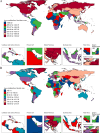Global burden of cancer and associated risk factors in 204 countries and territories, 1980-2021: a systematic analysis for the GBD 2021
- PMID: 39614359
- PMCID: PMC11607901
- DOI: 10.1186/s13045-024-01640-8
Global burden of cancer and associated risk factors in 204 countries and territories, 1980-2021: a systematic analysis for the GBD 2021
Abstract
Background: Cancer is the second most common cause of death globally. Therefore, it is imperative to investigate cancer incidence, mortality rates, and disability-adjusted life years (DALYs) to enhance preventive measures and healthcare resource allocation. This study aimed to assess cancer burden and associated risk factors in 204 countries and territories between 1980 and 2021.
Methods: We selected data on cancer incidence and mortality rates and associated risk factors from the global burden of disease (GBD) study tool for 204 countries and territories from 1990 to 2021 and 1980 to 2021. We estimated the age-standardized incidence (ASIR) and age-standardized deaths (ASDR) of 34 cancer types categorized as level 3 causes based on the GBD hierarchy.
Results: In 2021, cancer accounted for 14.57% (95% uncertainty interval: 13.65-15.28) of total deaths and 8.8% (7.99-9.67) of total DALYs in both sexes globally. ASIR and ASDR were 790.33 (694.43-893.01) and 116.49 (107.28-124.69), respectively. Additionally, females exhibited higher ASIR than males (923.44 versus 673.09), while males exhibited higher ASDR than females (145.69 versus 93.60). This indicates that policymakers should focus on the importance of gender equality in healthcare. Non-melanoma skin cancer exhibited the highest ASIR (74.10) in both sexes, while digestive cancers accounted for 39.29% of all cancer-related deaths, and Asia exhibited the heaviest cancer burden. In females, breast cancer exhibited the highest ASIR (46.40) and ASDR (14.55). In males, tracheal, bronchial, and lung cancer exhibited the highest ASIR (37.85) and ASDR (34.32), highlighting the urgent need for targeted tobacco control measures. Different cancers in various countries exhibit unique characteristics. Therefore, policymakers should formulate specific prevention and control strategies that reflect the cancer in their country. Tobacco was the primary level 2 risk factor for cancer DALYs in males. It accounted for 29.32% (25.32-33.14) of all cancer DALYs. Dietary risks, alcohol consumption, and air pollution accounted for 5.89% (2.01-10.73), 5.48% (4.83-6.11), and 4.30% (2.77-5.95) of male cancer DALYs, respectively. Therefore, policymakers should prioritize smoking regulation and other carcinogenic risks.
Conclusion: Cancer is a significant public health concern globally. Understanding the common etiologies of different cancers is essential for developing effective control strategies and targeted interventions.
Keywords: Cancer; GBD; Global; Incidence; Mortality.
© 2024. The Author(s).
Conflict of interest statement
Declarations. Ethics approval and consent to participate: Lin rong acting as the submission's guarantor responsibility for the integrity of the work as a whole, from inception to published article. All authors approved the final version of the manuscript. Conflict of interest: The authors declare no competing interests.
Figures





References
-
- Global Burden of Disease 2019 Cancer Collaboration; Kocarnik JM, Compton K, et al. Cancer Incidence, Mortality, Years of Life Lost, Years Lived With Disability, and Disability-Adjusted Life Years for 29 Cancer Groups From 2010 to 2019: A Systematic Analysis for the Global Burden of Disease Study 2019. JAMA Oncol. 2022 Mar 1;8(3):420–444. - PMC - PubMed
-
- Bray F, Laversanne M, Sung H, Ferlay J, Siegel RL, Soerjomataram I, Jemal A. Global cancer statistics 2022: GLOBOCAN estimates of incidence and mortality worldwide for 36 cancers in 185 countries. CA Cancer J Clin. 2024;74(3):229–63. - PubMed
-
- Bray F, Parkin DM; African Cancer Registry Network. Cancer in sub-Saharan Africa in 2020: a review of current estimates of the national burden, data gaps, and future needs. Lancet Oncol. 2022 Jun;23(6):719–728. - PubMed
Publication types
MeSH terms
LinkOut - more resources
Full Text Sources
Medical

